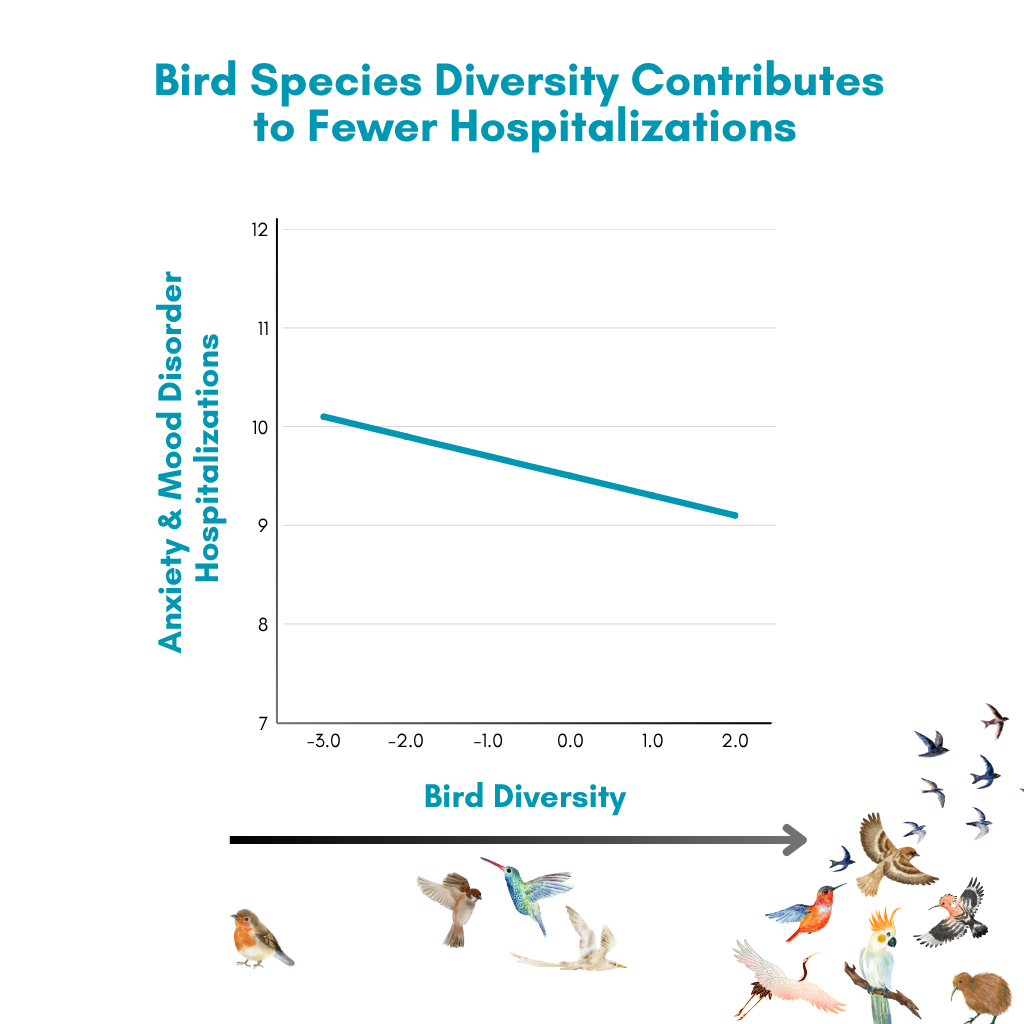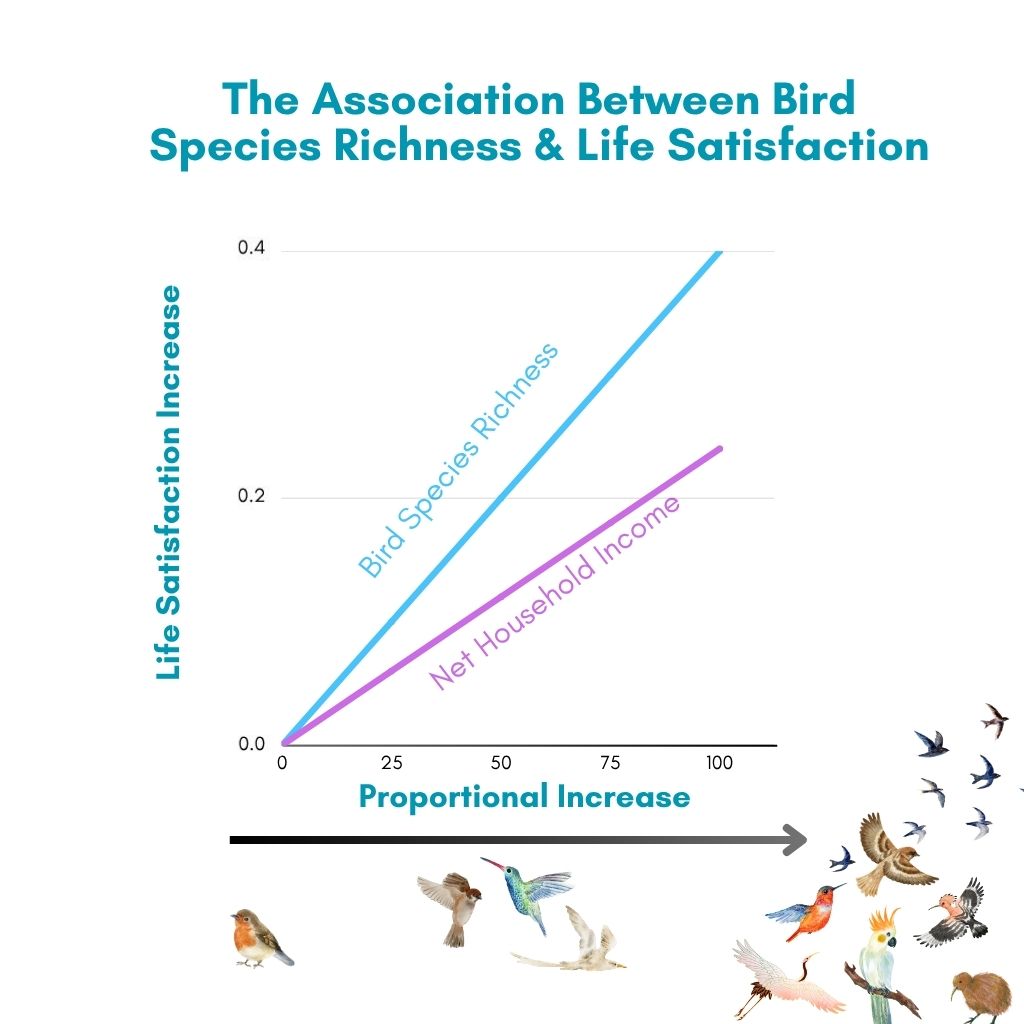What If Paying Attention Could Make You Feel Better?
No special tools. No routines to master. Just a few quiet moments of noticing.
It might sound too simple to be true, but research shows that paying attention to birds—their colors, calls, movements, or even just their presence—can support mental health in surprising ways. A moment of awareness can lift your mood, reduce stress and remind you of your place in the bigger picture1.
Across the world, millions of people find joy in birds, and it’s easy to see why. With so much variety in their colors, shapes, and personalities, birds remind us that nature is never far. You don’t need to live near a forest to experience their presence. In fact, birds often show up in places we least expect, if we’re paying attention.
Graph 1: Marginal effects plot of predicted anxiety/mood disorder hospitalisations at all levels of bird species diversity.

Where Are Birds Most Noticeable?
Birds are around us more often than we realize. Here are a few places they tend to stand out:
- In cities and suburbs: Watch rooftops, power lines, and lamp posts. You’ll often see pigeons, swallows, or starlings lined up like little sentinels.
- Public parks and schoolyards: These green spaces attract magpies, sunbirds, and the occasional parrot or oriole, depending on the region.
- Balconies, gardens, and window sills: Even the smallest space with plants or a bowl of water can become a bird’s resting spot.
- Near water and rice fields: Egrets, kingfishers, and herons can be seen in paddies, ponds, or along coastlines, especially in rural areas.
- After the rain: Birds often become more active after a downpour, emerging to feed and sing.
Whethere you’re in a busy city, a seaside town, or a quiet neighborhood, there are birds nearby, quietly living their lives alongside yours.
Their behavior can be playful, bold, curious, or quietly observant. Whether it’s a cheeky wren, a serious crow, or a soaring hawk, birds offer a continuous connection to something older and bigger than us. Even on the busiest street, they remind us we’re never truly separated from nature.
The sound of birds can also shift how we feel. A soft coo, a warble, or the gentle dawn chorus can bring us back to our breath. This calming effect runs deep. For millions of years, birdsong has served as a signal of safety—when birds are singing, predators likely aren’t nearby. That ancient signal still works today. It soothes our nervous system without us even realizing it.
Science has shown that birdsong can improve mood, focus, and problem-solving, and reduce anxiety and paranoia. And it’s not just the sounds. Seeing different types of birds together—what researchers call biodiversity—is linked to greater happiness and life satisfaction to a similar magnitude as that of income.
Graph 2: Marginal effects plot of predicted anxiety/mood disorder hospitalisations at all levels of bird species diversity (shaded lines represent 95% confidence intervals), showing a weak, negative association.

The good news? You don’t have to become a bird expert to benefit. Here are some simple ways to make birds part of your daily rhythm.
Simple Practices to Connect With Birds
1. Pause and Listen
Stop for a moment during your walk or while sipping coffee near an open window. Tune in. Notice the patterns, tones, and variety in the songs. Let them be your soundtrack for a few minutes.
2. Look Up and Around
Birds are everywhere. Glance at trees, rooftops, wires, or hedges. Watch for fluttering movement. You’ll be surprised how quickly your eyes adjust to spotting the small, delightful motions of life.
3. Make It a Daily Habit
Whether it’s on your way to work or during your afternoon break, choose a consistent time to check in with the birds around you. This regular practice builds a subtle sense of calm and grounding over time.
4. Notice the Ordinary
It doesn’t have to be a rare species. A common pigeon or sparrow can offer just as much joy when you take a moment to observe it. What’s it doing? How is it moving? Where is it looking? Let yourself be curious.
5. Be Still and Let Them Come
Find a spot to sit quietly—on a bench, a porch, or even a patch of grass. If you stay still, birds often come closer. They’re curious too. This shared moment of stillness is where connection often blooms.
Learning to pay attention to birds is not just a practice in observation. It’s a gentle reminder that you are part of something larger. These aren’t just birds. They’re nature’s messengers. They’re reminders to slow down, breathe, and remember that joy and connection can be found in the smallest, most ordinary moments.
You don’t need to be anywhere special. You just need to notice.
References:
1. Buxton, R. T., Pearson, A. L., Lin, H.-Y., Sanciangco, J. C., & Bennett, J. R. (2023). Exploring the relationship between bird diversity and anxiety and mood disorder hospitalisation rates. Geo: Geography and Environment, 10, e00127. https://rgs-ibg.onlinelibrary.wiley.com/doi/pdf/10.1002/geo2.127
2. Chang, C.-C., Oh, R. R. Y., Le Nghiem, T. P. L., Zhang, Y., Tan, C. L. Y., Lin, B. B., Gaston, K. J., Fuller, R. A., & Carrasco, L. R. (2020). Life satisfaction linked to the diversity of nature experiences and nature views from the window. Landscape and Urban Planning, 202, Article 103874. https://doi.org/10.1016/j.landurbplan.2020.103874
3. Hammoud, R., Tognin, S., Burgess, L., et al. (2022). Smartphone-based ecological momentary assessment reveals mental health benefits of birdlife. Scientific Reports, 12, 17589. https://doi.org/10.1038/s41598-022-20207-6
4. Max Planck Society. (2022, October 17). Birdsong is good for mental health. Max Planck Institute for Human Development. https://www.mpg.de/19373671/1017-bild-pm-2022-october-149835-x
5. Methorst, J., Rehdanz, K., Mueller, T., Hansjürgens, B., Bonn, A., & Böhning-Gaese, K. (2021). The importance of species diversity for human well-being in Europe. Ecological Economics, 181, 106917. https://doi.org/10.1016/j.ecolecon.2020.106917.
6. Methorst, J., Bonn, A., Marselle, M., Böhning-Gaese, K., & Rehdanz, K. (2021). Species richness is positively related to mental health – A study for Germany. Landscape and Urban Planning, 211, Article 104084. https://doi.org/10.1016/j.landurbplan.2021.104084
7. White, M. P., Alcock, I., Wheeler, B. W., & Depledge, M. H. (2020). Life satisfaction is linked to the diversity of natural experiences. Landscape and Urban Planning, 194, Article 103689. https://doi.org/10.1016/j.landurbplan.2019.103689
8. Wild Bird Feeding Institute. (2023, July 11). The soothing melody of birds: Exploring the mental health benefits of nature’s song. https://www.wbfi.org/2023/07/11/the-soothing-melody-of-birds-exploring-the-mental-health-benefits-of-natures-song/
